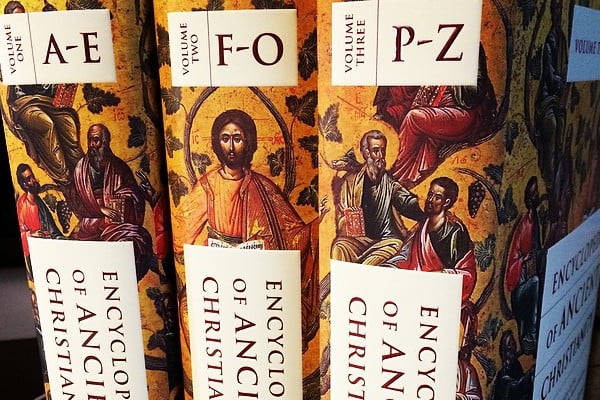
I’ve had about a week to thumb through InterVarsity Press’s magisterial Encyclopedia of Ancient Christianity, though I’ve only digested a fraction of its 3,000-plus pages.
With the Ancient Christian Commentary on Scripture and Ancient Christian Texts, IVP has become an important source for patristic studies in English. The arrival of the EAC only cements that appraisal. Every pastor, scholar, student, and hobbyist (like me!) needs it — or at least easy access.
The material is, as you would hope, exhaustive. It covers roughly 800 years of church history with entries for key figures, events, concepts, and practices. The entry on John Cassian was fascinating, ditto Irenaeus of Lyons.
Icongographic and typological traditions are frequently discussed for biblical figures. Samson, for example, was seen as a type of Christ. Given Samson’s immorality, that might rub some the wrong way. But early Christians equated Samson’s destruction of the Philistines with Christ’s destruction of death and hades.
One cemetery fresco mentioned in the entry features Samson standing over a dead lion, the beast’s mouth buzzing with bees living in the maw — a reference to Judges 14. Why would early Christians have painted that image in a tomb? They considered Samson’s victory over the lion an icon of Christ’s victory over Satan, and the honey in the lion’s mouth of life eternal (see, e.g., Ambrose of Milan, On the Holy Spirit, introduction).
Understanding Christ’s saving activity as a victory over humanity’s enemies (death and the devil) comes through in other entries as well. Note this from the entry on redemption:
[R]edemption is equivalent to the ransom paid by Christ to deliver humankind from the forces of evil (the devil, demons and cosmic powers). Because, however, behind the metaphor of ransom, taken from military language (prisoners of war) rather than legal-mercantile language (slavery) . . . there is the idea of liberation, it is also necessary to take into consideration the categories and images that evoke the same idea of liberation. . . . [T]hese motifs are continually intertwined not only among each other but but also with other soteriological themes. . . .
Salvation was seen less as a legal transaction and more as a battle of liberation, which is certainly one of the reasons why the Exodus serves as a governing theme in Christian theology and why Moses is seen as a type of Christ.
There are gems like this throughout. With every few pages something leaps out to provoke, fascinate, and enthrall. If you want access to the mind of the ancient church, I can think of no better place to begin.










